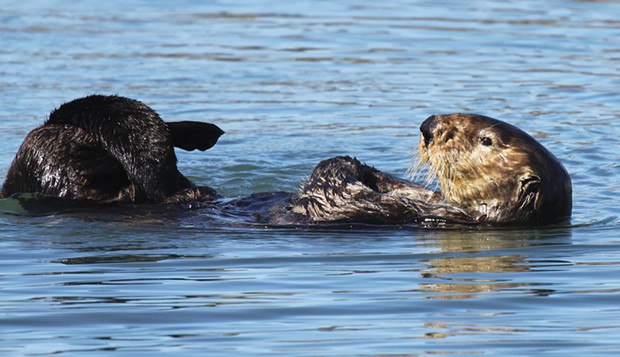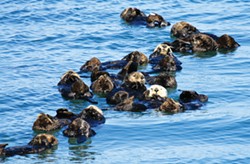USFW Taking First Steps in Possible Reintroduction of Sea Otters
By Kimberly Wear [email protected] @kimberly_wear
Photo by Lilian Carswell/USFWS
By rubbing their flippers and forepaws simultaneously, sea otters increase the efficiency of a grooming session.
[
{
"name": "Top Stories Video Pair",
"insertPoint": "7",
"component": "17087298",
"parentWrapperClass": "fdn-ads-inline-content-block",
"requiredCountToDisplay": "1"
}
]
At an open house hosted by the U.S. Fish and Wildlife Service to gather input on the possible reintroduction of sea otters to parts of their historical range from the Bay Area to Oregon, a phrase repeated often was the process was still "on the ground floor."
The informal Sunday event on the Cal Poly Humboldt campus — one of 16 to take place in West Coast coastal communities from Astoria to Emeryville — saw USFW staff, including sea otter experts, manning a series of tables with presentations on everything from the endangered species' biology and role as a keystone species to previous reintroduction efforts and potential socio-economic effects on local communities, as well as next steps.
While the staff was there to answer questions, one of the key points of the sessions, they said, was to listen and take in feedback as the service begins the information-gathering portion of an extensive process that will be years in the works before any decision on whether to proceed is made.
"We are interested in hearing a range of perspectives," said Lilian Carswell, USFW's southern sea otter recovery and marine conservation coordinator, adding that includes people's thoughts on reintroduction and their concerns, especially on the socio-economic front. "We are way at the beginning and we want to hear from people and really want to understand their perspectives."
The sessions are just the beginning of many more opportunities for the public to weigh in, said USFW spokesperson Susan Sawyer, with these events also providing the service an opportunity to share what's known at this point but primarily to see what people think.
"Mostly it's a listening tour," she said. "We want to hear from the community."
In the summer of 2022 — at the direction of Congress — the USFW released a report that found reintroduction is biologically, socioeconomically and legally feasible, but the 200-page assessment also noted that far more research is needed to narrow down potential landing spots, along with additional public outreach and studies on possible socioeconomic impacts. The USFW assessment focused on the Bay Area and up the California coast while a companion assessment that focused on bringing sea otters back to Oregon was done by the nonprofit Elakha Alliance.
USFW has not taken a position at this point on whether to move forward.
Nearly driven to extinction by the fur trade, a 900-mile gap now separates the northern and southern sea otter populations that are believed to have once numbered into the hundreds of thousands across a wide expanse of the Pacific Ocean — from northern Japan to Baja California — including the coastal waters of Humboldt, Del Norte and Mendocino counties.
Only a few hundred remained in small, isolated pockets, mostly around Alaska, where they now number around 25,000, by the time a 1911 international treaty made it illegal to kill the furry sea mammals whose luxuriant fur pelts were widely coveted. In California, sea otters were considered completely lost until approximately 50 were discovered by chance in a remote section of the Big Sur coastline in 1938.
Extensive conservation efforts over the last eight decades have seen that last stand colony — the direct forebearers of the entire current southern sea otter population — increase to some 3,000 otters.
In January, the Center for Biological Diversity filed a formal petition urging USFW to initiate the process over "a large stretch of the West Coast," citing dangers faced by the geographically isolated southern sea otter and the need to reconnect the two subspecies to expand the genetic pool, help the animals better adapt to climate change and provide a buffer in the case of a catastrophic event, like an oil spill or disease outbreak.
While the northern sea otter population has expanded its range, its southern cousins have been hewed into a section of the Central California coastline, with disease, pollution and sharks creating a barrier to their ability to spread out to other areas.
Human intervention via relocation efforts is believed to be the only path for bridging the gaping void between the two populations. Otters' reintroduction would also bring the potential added benefit of helping restore the North Coast's beleaguered bull kelp ecosystem by bringing back a keystone predator missing for generations.
"In the assessment, we determined that reintroducing sea otters to parts of their former range could help restore nearshore ecosystems, increase gene flow between sea otter populations, benefit the threatened southern sea otter and provide overall economic gains to coastal communities," Carswell said in a previous email to the Journal. "As we go forward, we'll be working with scientists and a broad range of stakeholders to make sure any actions we're considering are fully vetted and that we're taking into account input from everyone who might be affected."
But, the assessment notes, there are risks involved for the individual animals during relocation and potential losses are inherent in any attempt. However, not intervening comes with its own risks.
"As long as the bulk of the southern sea otter subspecies remains concentrated in one isolated stretch of coast, it is vulnerable to catastrophic events, such as a large oil spill, that could effectively eliminate the source population," the assessment states. "The risk of such an unforeseen event, even if extremely unlikely in any one year, poses a significant threat to the southern sea otter while waiting for the population to expand on its own. ... We therefore conclude there is a risk with inaction, and that risk is greatest for the threatened southern sea otter due to diminished adaptive capacity and a lack of redundancy in populations."
As of now, there's still a long list of what needs to be done, including identifying possible relocation sites as well as identifying potential socioeconomic impacts for further study, bringing together stakeholders and developing mitigation strategies, which would all need to be done before USFW decides whether to even propose reintroduction.
"There's a lot of homework to do first," said Michele Zwartjes, one of three main authors of the USFW assessment, noting there's a couple more years of information gathering and there will be many more opportunities for the public to weigh in.
At this point, the main idea is making sure coastal communities are "aware this conversation is starting."
For more information on USFW's exploration of sea otter reintroduction and ways to give input, visit fws.gov/project/exploring-potential-sea-otter-reintroduction.
Kimberly Wear (she/her) is the Journal's digital editor. Reach her at (707) 442-1300, extension 323, or kim@ northcoastjournal.com.
more from the author
-
Dust to Dust
The green burial movement looks to set down roots in Humboldt County
- Apr 11, 2024
-
Our Last Best Chance
- Apr 11, 2024
-
Judge Rules Arcata Can't Put Earth Flag on Top
- Apr 5, 2024
- More »
Latest in News
Readers also liked…
-
Through Mark Larson's Lens
A local photographer's favorite images of 2022 in Humboldt
- Jan 5, 2023
-
'To Celebrate Our Sovereignty'
Yurok Tribe to host gathering honoring 'ultimate river warrior' on the anniversary of the U.S. Supreme Court ruling that changed everything
- Jun 8, 2023
































